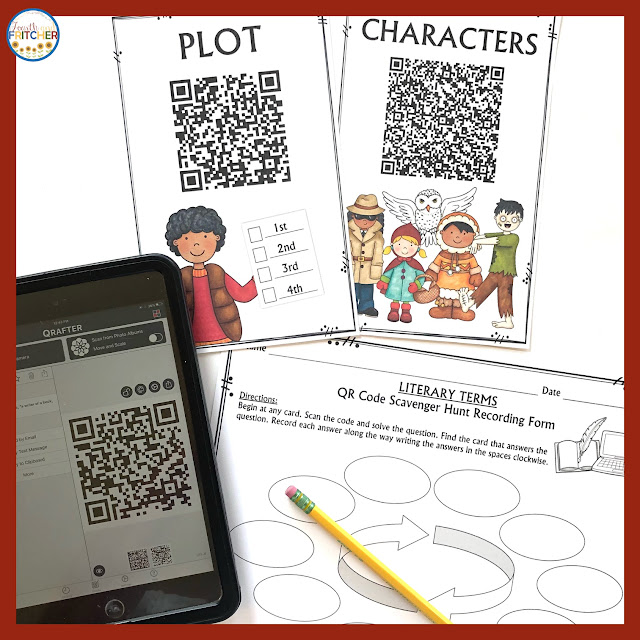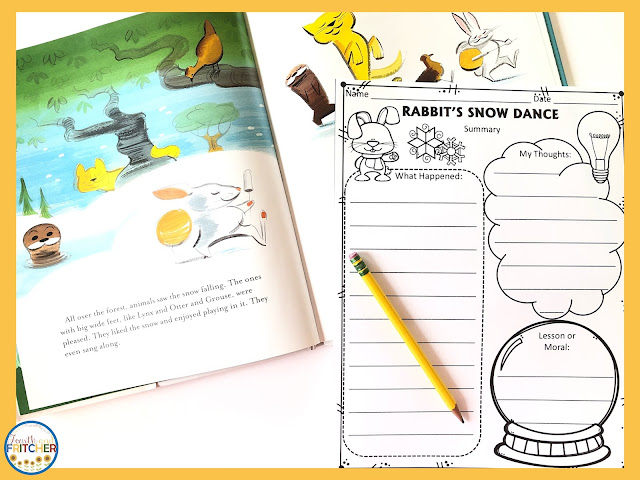It's time for back to school! Are you ready? Do you have your lessons planned and your materials ready to go? I always find the first couple weeks of school some of the most exciting (and challenging) to plan.
Trying to find a good balance between Team Building and Academics can be tough. In addition, there is the added challenge of trying to re-engage brains that have been on summer break. How much are they going to remember? What information will need to be reviewed?
Save yourself time and frustration by using picture books, QR Codes, and a little bit of strategy!
EASY BACK TO SCHOOL 3 STEP STRATEGY
1. Choose a Picture Book
To help meet back to school challenges I use picture books! Picture books are a great way to build community through discussions, review skills or content, and also introduce new material. Picture books have the added benefit of offering flexibility to teachers when planning lessons and meeting the needs of all learners.
Students in the upper elementary grades appreciate a picture book, it's too often that they are expected to read and respond to only novels. There is a certain reduction in cognitive load when using picture books.
2. Print the Materials
Plan for print and go materials. Once you have a book in hand, the next step will be to print your materials. Choosing items that can be sent to the printer and have minimal prep will make your back to school planning easier than ever.
Once printed, sort out your materials based on when you will need them for your lessons. I also grab one copy of each printed page to keep in my plan book for reference as I work my way through the unit.
3. Plan Your Pacing
Once you have a plan for which materials you will be using, plan your pacing. Think about using each picture book in two chunks of lessons. The first chunk of your lessons will be to address the reading standards. The second chunk of your lessons will be to address the writing standards.
Choose a picture book that will lend itself to a connected writing piece. For instance, if you are reading a fairy tale, plan for students to write their own fairy tale. The first chunk of lessons should focus on things such as: components of the text, how the author structured the story, or the elements that make the story entertaining. Build your student's knowledge base about the text structure.
Then, when the second chunck of lessons are delivered for writing, students will have a firm grasp of how to draft their writing and structure their own story. They will also have the notes and responses from the picture book to remind them of what good writing looks and sounds like.
VOCABULARY & QR CODE ACTIVITIES
Vocabulary is such a key component in learning; especially in content areas. And, let's face it, it can be pretty dry and boring. So, I am always looking for ways to make it a bit more engaging for the students.
To start, it helps to have visually appealing word cards (font and graphics). I prefer word cards that have some sort of icon to help students anchor the word in their brains. Engaging different parts of the brain when working with vocabulary will give students more than one area to pull from when they encounter or use the word later on.
Aside from word cards with graphics, it's also good practice to have students breaking the words down, doing their own word work, and looking at other ways the word shows up in our language.
I like to have several copies of vocabulary worksheets printed and ready to go at any given moment. Not every word works with both sheets. Some words lend themselves better to one over the other. And, I don't break down every word. I will choose a word or two that I want the students to truly master. Those are the words I use to extend the learning and plan time for a deeper dive into the word.
 |
| Literary Terms; Vocabulary Worksheets |
Once students have had some exposure to and use of the words, QR Code scavenger hunts are a great way to reinforce and celebrate their learning. They are one of the most popular activities in my classroom. There is something magical about scanning a code and completing a task.
For the first hunt of the year, students will be working their way around the room matching literary terms to definitions. Beginning with literary terms is a great way to open the year because students should have some working knowledge of the terms, it's great for review, and gets their brains geared for the school year. Plus, I know I will be using these terms regularly throughout the year. The deeper the mastery of the terms, the easier subsequent lessons will be.
QR Code hunts are also a great way to get students out of their seats while working on mastery of the material while building community. Students typically complete the hunts with a partner but they can be done individually as well.
To Prep:
- Print and post the codes around the room.
- Print recording forms (if students are working in pairs/triads, teachers will need to decide if students will share a recording form or be responsible for their own).
 |
| Literary Terms; QR Code Scavenger Hunt |
Click HERE to get the Literary Terms Vocab Kit!
NATIVE AMERICAN PICTURE BOOKS
In the fall I use the following picture books to enhance my lessons about the Haudenosaunee while simultaneously hitting on many of the reading and writing standards. Although students will gain a lot of knowledge reading nonfiction text, I like to incorporate fiction and picture books whenever possible. The change up in text and illustrations keep the interest level up and the students engaged with the content.
The Rough-Face Girl
I can still recall the first time I heard this Native American Cinderella tale. The illustrations were as powerful then as they are now. Accompanied by David Shannon's masterfuly crafted illustrations are Rafe Martin's words telling this timeless tale which highlights those things which are most sacred to Native Americans.
I love to use this book to examine character traits and delve into the values and beliefs of the Haudenosaunee culture. Students have an opportunity to evaluate the charcters and their behaviors. This book also provides excellent examples of simile, metaphor, and personification; not only through the words but the illustrations themselves.
Additionally, this picture book is a fantastic opportunity to lead your students through a compare and contrast writing piece. Most students are familiar with a Cinderella tale. However, even if they are not, it is easy enough to read another version to build up the knowledge base for the writing.
 |
| The Rough-Face Girl; Evidence Chart |
You can find find my print and go resource for The Rough-Face Girl HERE.
You can find plenty of read alouds for this picture book on the internet. Two that I like are listed below:
The Rough-Face Girl read by Rafe Martin
The Rough-Face Girl (Read Aloud)
Thirteen Moons on Turtle's Back
This beautifully illustrated text leads readers through the 13 moons in a year as a grandfather teaches his grandson about the significance of the turtle and its connection to the moons; thirteen different moons as observed and celebrated by thirteen different nations.
Within the poetry that presents like prose, students will learn about the time of year, the cultural traditions of the people, as well as experience interwoven personification that brings nature to life for each moon's story.
Thirteen Moons gives readers another look at the Native culture which views many elements of nature as people/beings that have direct impact on our Earth and demonstrate how all things are connected.
Students can examine the construct of the Lunar Calendar versus the Gregorian Calendar. This will give students an opportunity to craft an opinion writing piece about which calendar they prefer.
 |
| Thirteen Moons on Turtle's Back; Moon Note Catcher |
You can find find my print and go resource for Thirteen Moons on Turtle's Back HERE.
Teachers can use the two links below to enhance the students' experience with the text and give them a deeper understanding of Native culture.
Chris & Kathy: 13 Moons on turtles back a Native American calendar.
George Couchie and Faith: 13 moons on a Turtles back
Rabbit's Snow Dance
Who doesn't love a fable? This funny and entertaining traditional Iroquois fable invites readers to watch Rabbit's attempt to make snow during the summer. Told with changing fonts and perfectly paired illustrations, readers are transported to a world where the animals are characters that have personality flaws and will learn a lesson by the end of the tale.
Students will encounter a traditional Iroquois drum and song as Rabbit brings on snow in the midst of summertime! Along with the interwoven drum and song, students will learn how Native Americans explain the existence of pussy willows. This fable gives students a simple story that cleverly incorporates many of the cultural beliefs and traditions of the Iroquois.
After students have had an opportunity to read and break down the different elements of this fable, they are then set to write one of their own! Rabbit's Snow Dance is a simple and direct way to build up a student's knowledge base for drafting their own fable. A fable is a structured creative writing piece that lends itself to many different approaches and gives the students an opportunity to truly put their creative juices to work.
 |
| Rabbit's Snow Dance; Summary Sheet |
You can find find my print and go resource for Rabbit's Snow Dance HERE.
There are many read alouds for this picture book on the internet. Two options are listed below (the first link read aloud is more decorative with graphics and music, the second is a more direct and simplistic approach).
Read Aloud Rabbit's Snow Dance
Rabbit's Snow Dance
Other PRINT and Go Picture Book Resources:
American Revolutionary War Stories BUNDLE
Other Picture Book Blogs: